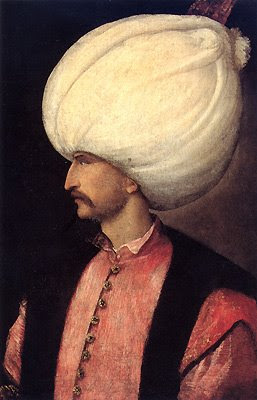According to legend, İstanbul was founded in 667 bc by a Greek colonizer, Byzas the Megarian, from whom the city’s original name, Byzantium, is derived. Because of Byzantium’s strategic and economic importance, Athenians, Persians, Spartans, Macedonians, and Romans fought over the city for centuries.  ( Constantine the Great )
( Constantine the Great )
In 324 ad Roman emperor Constantine the Great defeated rival emperor Licinius at Chrysopolis (now Üsküdar) and became the sole Roman emperor.
Constantine made Byzantium his capital in 330, expanding the city until it rested on seven hills, like Rome.
The city was soon called Constantinople, meaning “city of Constantine.”
Constantinople became the capital of the Byzantine Empire—the eastern part of the Roman Empire, which survived the fall of Rome in the 5th century—and subsequently developed into the center of the Greek Orthodox Christian world.
Beginning in the 4th century, Constantinople hosted eight councils of the Christian church. ( Justinian I )
( Justinian I )
Constantinople reached its peak during the reign of Byzantine emperor Justinian I (527-565), who is responsible for some of the city’s greatest architectural monuments, including Hagia Sophia. Following a plague in 542, the city entered a period of decline.
Between the 7th and 11th centuries Persians, Avars, Arabs, Bulgarians, and Rus (East Slavs) attacked Constantinople.
In 1204, during the Fourth Crusade, the city was seized by the Latin (Roman Catholic) Crusaders, who held it until 1261 when Byzantine rulers recaptured the city.
The Fourth Crusade and its aftermath, which included a long series of family struggles for the title of emperor, sapped the Byzantine Empire of its resources and wreaked havoc on its capital city.
In 1453 Constantinople fell to the Ottomans, who made it the capital of the Ottoman Empire and called it İstanbul.  ( Sultan Suleman )
( Sultan Suleman )
Under Ottoman rule, the city flourished as a political, commercial, and cultural center, reaching its height under Sultan Süleyman I (1520-1566). Soon after, however, İstanbul entered a period of slow and steady decline.
The Ottoman Empire grew weaker as the sultans became less effective leaders.
İstanbul was the site of several riots and rebellions, most notably the 1826 revolt of the Janissaries, the elite Ottoman military corps, which ended in the dissolution of the corps. After this point, İstanbul saw reforms along Western lines, as European ideas of administration and development were brought into the city by increasing numbers of foreign visitors.
During World War I (1914-1918) Allied forces defeated the Ottoman Empire. At the end of the war, İstanbul came under Allied occupation.  ( Mustafa Kemal )
( Mustafa Kemal )
Following the Turkish War of Independence (1919-1922), the nationalist army of Mustafa Kemal (later known as Mustafa Kemal Atatürk) expelled Allied troops from the city.
In 1923 Mustafa Kemal made Turkey a republic and moved the capital from İstanbul to Ankara, which was the center of the nationalist movement.
The city’s name was officially changed to İstanbul in 1930. İstanbul remains Turkey’s economic center, despite no longer being the capital. Its population has grown steadily, and in recent years, demands for improved road systems have led to some demolition of historic portions of the city.
Friday, March 21, 2008
History of Istanbul city
Posted by Star Light at 9:16 AM
Subscribe to:
Post Comments (Atom)
0 comments:
Post a Comment